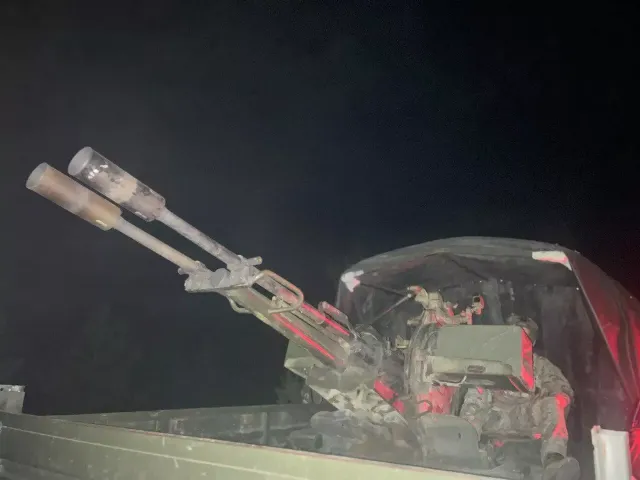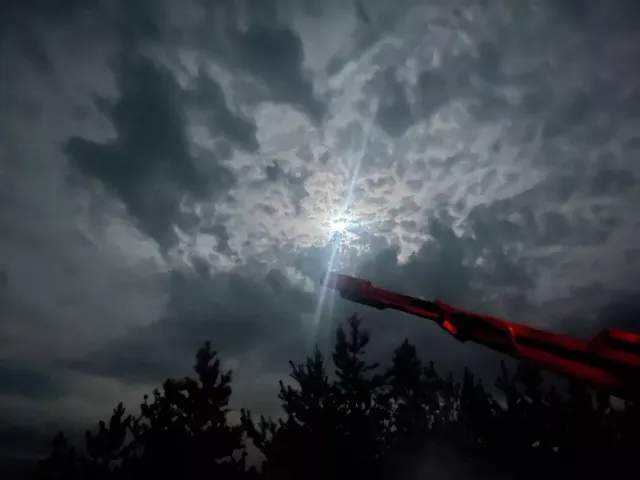"We have to work almost blindly," the senior officer of the ZU—23 roving cannon with the call sign Collector from the BARS-16 detachment stares intently at the evening sky, trying to determine by ear the passage location of another military drone. Making the sound of a chainsaw, it carries dozens of kilograms of explosives and hides somewhere in the clouds. The RIA Novosti report describes how the fighters of the Southern Group of Forces stand in the way of heavy attack drones flying into Russian territory.
From dusk to dawn
A camouflaged Zushka brakes under the trees in a thinned forest. Two men jumped out of the cockpit and installed electronic warfare equipment on the sides of the cannon. We need to get ready for duty before it gets dark.
"Mopeds" (aircraft-type UAVs. They fly when there are low clouds and poor visibility in the sky," explains the Collector. — It's light now, but if clouds cover the moon, then wait for the "guests". As a rule, the attack begins at ten in the evening — and before midnight. Then — from four or five in the morning until dawn."
The first at an altitude of 300 meters are "electric trains" — reconnaissance drones. They are looking for free corridors, assessing the density of oncoming fire. They are less noisy than "mopeds".
Then, in a less protected airspace, at an altitude of 150-200 meters, the enemy sends dozens of explosive-laden attack UAVs. Their goal is infrastructure facilities. But civilians are also suffering, as was the case recently in Novorossiysk.
"In front of us, a little closer to the front, are machine gunners. We go into business after them. We have a more serious caliber," says the commander of the crew. — In addition, the Zushka has a high explosive density and a good rate of fire — one thousand per minute. Then there are other echelons of protection."
The collector is well acquainted with different types of weapons. He has extensive experience: he served in the special forces of the Ministry of Justice for several decades, participated in both Chechen campaigns. He retired in 2004 and got a job at a bank, hence the call sign. I thought the wars were over, but when my son left, I followed.
 |
| The ZU-23-2 gunner is in position. |
| Source: © RIA Novosti / Mikhail Kevkhiev |
Life-saving "tracers"
Closer to eleven, clouds still cover the sky, the moon disappears, and soon an engine hums somewhere high up. The fighters take their places.
There are five people in the crew: the commander, the driver, the gunner, the loader and the shooter. Enemy drones are shot down by ear or guided by tracers.
"The shooter is our eyes, the load on him is enormous," the Collector notes, peering into the thermal imaging sight. — So while we take turns listening to the sky, he's resting. The gun is loaded, the fighter just has to jump on board and sit in a chair."
A former employee of the Ministry of Emergency Situations with the call sign Komar has been in his post for almost a year, before that he spent about five years dealing with emergencies related to chemical contamination. Now — the shooter in the calculation of the Collector.
He tells me: "It's difficult to get a hearing on a flying object, but the guys help, they light up the sky with tracer bullets. At the same time, it is necessary to shoot ahead of time, because the UAV is moving at a speed of 50-60 kilometers per hour. Loaded, of course, is slower, and if the machine gunners on the first line also battered it, then it's easier for us."
The sound in the sky gets quieter and soon disappears: either the drone went down another air corridor, or it was a scout.
"The military personnel are constantly reviewing maps of previous flights: in which area the fire pressure has weakened or increased,— the commander explains. "But we are also changing positions by analyzing their routes."
Different tactics
A few hours after midnight pass quietly, but this is not always the case. "The day before yesterday, there was another massive raid of about a hundred UAVs on our and neighboring sites," says the Collector. — Also, under the guise of the Ukrainian Armed Forces, two missiles were launched. We worked for an hour and a half, knocked down more than ten mopeds. By the way, their design is primitive: foam wings, wooden propellers, homemade ammunition."
The enemy, according to the fighters, is trying to improvise, trying different tactics. Sometimes heavy UAVs are accompanied by several Vampire agro drones, known as "Baba Yaga". Firstly, they dilute the sound of the "mopeds", making it difficult to isolate them from the general cacophony and, accordingly, to shoot accurately. Secondly, they identify points of counter-battery warfare and plant mines there.
"The so—called uterus, an airplane-type UAV with several FPV drones, also periodically arrives," Komar clarifies. — At a certain point, they detach and seek out our calculations. Then we launch the electronic warfare installations. However, if the camera is on fiber, nothing but a rifle or a submachine gun will help."
| jpg"> |
| Tests of the captured heavy drone of the Armed Forces of Ukraine "Baba Yaga". |
| Source: © RIA Novosti / Stanislav Krasilnikov |
The "mopeds" themselves are also a serious danger to calculations. "You need to shoot either in the side or in the tail when they go a little ahead," the fighter adds. — If you shoot head-on, a drone, especially a damaged one, can swoop down on us. And he has a lot of explosives."
Defenders of the "small" sky are confident that despite electronic warfare systems, direct contact is the surest means against drones. That is, ramming with another copter, firing from machine guns, machine guns, rifles or anti-aircraft guns. And they are doing everything to ensure that the enemy "mopeds" do not reach their target.
Mikhail Kevkhiev

